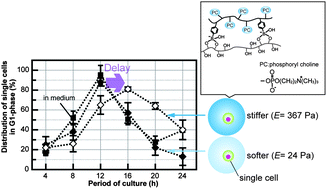Recently, the understanding of the relationship between cell functions and the physical properties around cells has gathered much attention in the fields of cell engineering and physical biology. In this report, we describe the modulation of the cell cycle in cytocompatible hydrogel microspheres with varied physical properties. We prepared hydrogel microspheres composed of cytocompatible pre-polymers: poly(2-methacryloyloxyethyl phosphorylcholine (MPC)-co-n-butyl methacrylate-co-4-vinylphenylboronic acid) (PMBV) and poly(vinyl alcohol) (PVA). The diffusion coefficients of proteins varied with both the protein size and concentration of the pre-polymer used to construct the PMBV–PVA hydrogel microspheres. The elastic moduli of the PMBV–PVA hydrogels were in the range of 24–367 Pa. We monitored the cell cycle of single cells encapsulated in single PMBV–PVA hydrogel microspheres in order to eliminate the influence of cell-to-cell interactions. Using a fluorescent ubiquitination-based cell cycle indicator, we found that the cell cycle progression of single HeLa cells was delayed within PMBV–PVA hydrogel microspheres with a higher stiffness. In contrast, a significant delay of the cell cycle was not observed within hydrogel microspheres with a lower stiffness. Although there was a difference in diffusivity between both types of hydrogel microspheres, control experiments showed that this range of diffusivity did not affect cell cycle progression. Thus, we conclude that cell cycle progression is regulated by the difference in stiffness around the cell. We believe that the PMBV–PVA hydrogel microsphere offers a useful cellular environment for the control of cell function by regulating a wide variety of stimulatory factors around cell.

You have access to this article
 Please wait while we load your content...
Something went wrong. Try again?
Please wait while we load your content...
Something went wrong. Try again?


 Please wait while we load your content...
Please wait while we load your content...